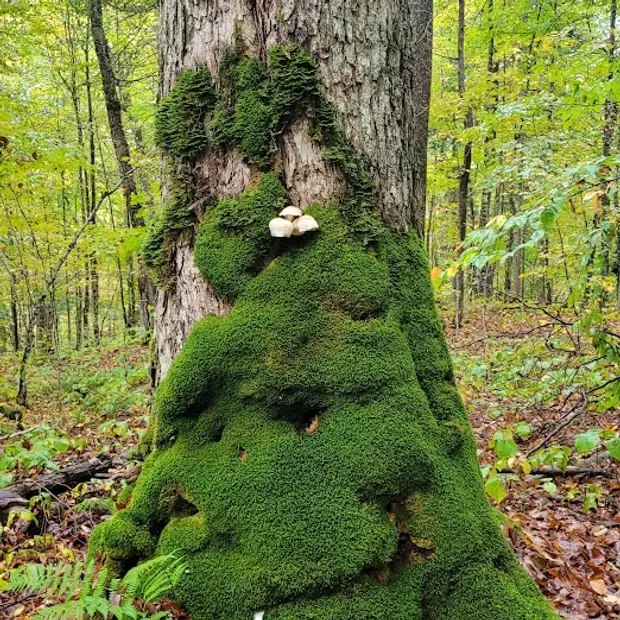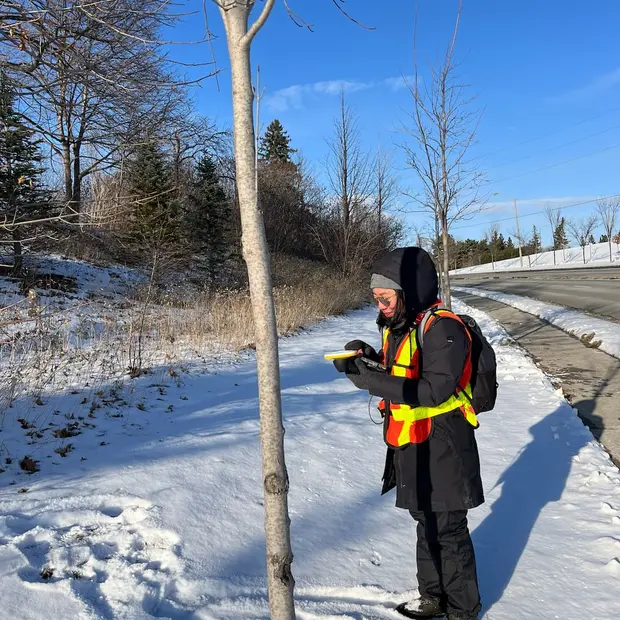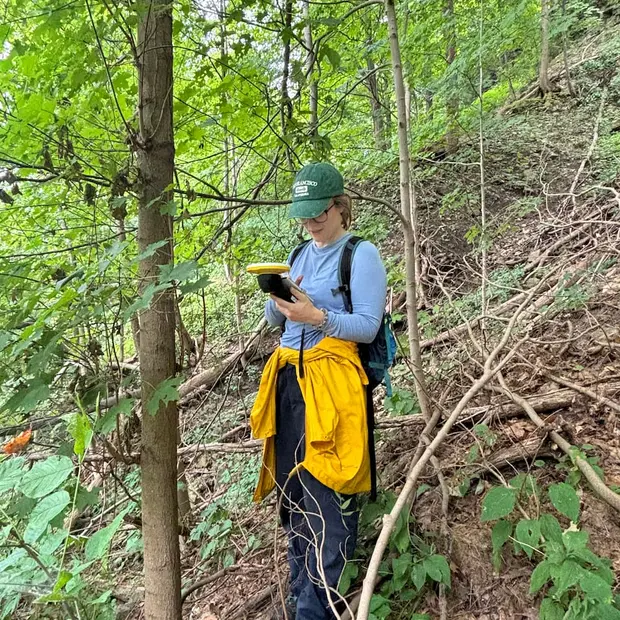Certified ISA Arborist Surveys
Certified arborist surveys for tree assessments and inventories.
Our team of ISA Certified Arborists® specializes in conducting tree inventories, tagging, and surveys to evaluate the potential impacts of proposed development or infrastructure projects on trees.
For trees that may present a risk to visitors, residents, or property, our TRAQ (Tree Risk Assessment Qualification) certified staff are available to conduct thorough hazard tree assessments, prioritizing safety while exploring preservation options.

Prioritizing preservation and compliance, while meeting your project goals.
We ensure compliance with local tree and woodlot management policies, providing expert recommendations for tree protection and mitigation strategies.
We pride ourselves in balancing developable space with retention of high quality, healthy trees that lend character and add value to your finished project. We work closely with our allied professionals - including civil engineers and planners – to support design development layouts that integrate trees as valuable assets, enhancing the overall site quality

We provide the following reports and mapping services depending on your project needs:
- Arborist reports
- Tree Preservation Plans
- Tree transplanting details
- Tree compensation plans
- Vegetation management plans
- Canopy cover assessment
- Urban forest management plans

Dougan Ecology has conducted detailed tree surveys for a wide range of clients for over four decades, including:
- Municipalities
- Private Companies
- Landowners
- Academic Institutions
- Planners
- Engineering Teams
- Landscape Architecture firms
Contact us today to discuss how our certified arborists can support your project with expert tree assessments and preservation planning.

Frequently asked questions about certified ISA arborist surveys
An ISA-certified arborist is a trained tree care professional accredited by the International Society of Arboriculture (ISA). In Ontario, ISA-certified arborists are recognized experts in tree identification, health evaluation, risk assessment, and protection planning. Dougan Ecology employs four ISA-certified arborists, including two with TRAQ (Tree Risk Assessment Qualification), to provide services critical to urban development, infrastructure projects, and regulatory approval processes.
Certified arborists are often required under municipal bylaws or local regulations to ensure tree preservation and compliance. Many Ontario municipalities require arborist reports for development or tree removal permits. An ISA-certified arborist ensures compliance, minimizes ecological risk, and supports the health and resilience of urban canopy assets.
Tree surveys may include a detailed tree inventory, health and growth-form condition rating, management recommendations, or other services. Surveys identify tree species, location (with GPS or GIS mapping), size (diameter), health, structural stability, and protection status under local bylaws. Arborist reports may also include preservation measures or removal justifications, or replanting strategies aligned with nature-based goals.
Tree health assessments typically involve visual inspections of canopy density, leaf condition, deadwood presence, trunk integrity, root zone stability, and signs of pests or disease. These assessments provide data to guide preservation decisions or removal when necessary.
A tree health assessment is generally required when development or site alteration may affect mature or protected trees,especially where such trees are integral to the natural heritage framework. These assessments are often part of planning applications, infrastructure design, or EIS processes, helping inform tree protection plans.
A TRAQ certified arborist can complete a tree risk assessment. Arborists with TRAQ (offered through the International Society of Arboriculture) are trained to identify potential hazards in individual or groups of trees, calculate the risk of the hazard causing harm, and provide recommendations to mitigate the risk. Dougan Ecology has two TRAQ certified arborists to assist with your tree risk assessments.
Arborist survey costs depend on property size, tree count, and reporting complexity. For small residential lots, pricing may start in the low thousands; larger sites or commercial, industrial, or mining projects requiring advanced mapping or integration into environmental or legal packages may incur higher costs.
A tree protection plan defines which trees to retain, protective fencing protocols, root protection zones, construction mitigation details, and preservation strategies aligned with local and regional bylaw requirements. TPPs are critical to preserving tree function during grading or excavation activities.
Not all arborists in Ontario hold ISA certification. The ISA credential is voluntary but signals adherence to rigorous professional standards. Municipalities and regulatory authorities typically prefer or require ISA-certified practitioners for formal assessments and arborist reports.
Arborists evaluate visible roots, soil conditions, and potential disturbance zones to estimate the Critical Root Zone (CRZ). They recommend setbacks, trenching techniques, or physical barriers to avoid root damage during development. This evaluation is essential to balancing tree protection with site alteration.
DBH (Diameter at Breast Height) is a standard measurement, 1.4 m above ground, that helps classify tree size and regulatory significance. Larger DBH trees are often prioritized for preservation or require higher compensation if removal is permitted.
Arborists support species at risk assessments by identifying protected tree species or habitat. Arborists may help identify regulated species such as Butternut or Black Ash and can identify potential habitat trees for endangered bats or protected birds. Their assessments feed into environmental and consulting packages supporting species-at-risk protection under provincial and federal legislation.
Yes. Although leaf-based diagnostics are limited, arborists can assess trunk form, bark condition, root area indicators, and structural stability during winter. This flexibility supports ongoing assessments outside the growing season.
A Butternut Health Assessment determines whether a Butternut tree is healthy, diseased, or hybridized. Because Butternut is endangered in Ontario, assessments must be done by certified Butternut Health Experts (BHEs). Dougan Ecology has qualified arborists to perform these assessments under ESA protocols, helping guide removal permitting or conservation decisions.
Butternut trees are endangered due to habitat loss, disease (Butternut canker), and hybridization with non-native species. Under Ontario’s ESA, it is illegal to harm or remove Butternut trees (or their habitat) without proper assessment and authorization. Protective buffers, often 25 m or more, are required around mature individuals, and health assessments determine whether exemptions apply.
Certified Butternut Health Experts (BHEs) can conduct authorized assessments in compliance with ESA regulations. At Dougan Ecology, our certified arborists and ecological consultants can perform these assessments and support permit applications or preservation planning.
Trees may be regulated by municipal bylaws, conservation authorities, or provincially (via the ESA) due to species, size, location, or ecological context. Trees in woodlands, ravines, or near wetlands are often subject to stricter oversight. Regulated status dictates the need for arborist reports and mitigation. Trees on urban properties are also often regulated to protect the urban tree canopy.
Often, yes. Many Southern Ontario municipalities require tree surveys during development approvals, rezoning, or site plan applications. Tree Management Plans or Arborist Reports must accompany applications to show compliance with canopy protection, replacement standards, and ecosystem preservation.
Tree conservation bylaws are local laws regulating tree removal and injury in many Ontario municipalities, including as Mississauga, Burlington, Hamilton, Ottawa, Niagara, York, Muskoka Lakes, and Orillia. These bylaws typically require permits for trees above a certain size or in designated zones. Tree surveys and arborist reports help authorities assess compliance and enforce canopy protection.
Tree preservation plans are prepared by ecological consultants or arborists (such as those at Dougan Ecology). These plans detail which trees to retain or remove, root protection strategies, fencing specifications, soil stabilization, and mitigation protocols. Well-crafted plans help reconcile construction needs with ecological integrity, maximize successful outcomes, and support long-term canopy health.
